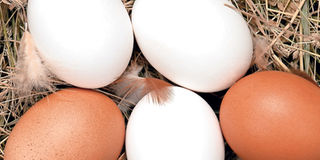Diary of a poultry farmer: All you wanted to know about egg incubation

When incubating eggs, any dirt on the eggs will introduce bacteria into your incubator. FILE PHOTO | NMG
What you need to know:
- Avoid very large or very small eggs, or those with abnormal shapes.
- Small eggs often don't allow enough space inside for the chick to develop while the larger ones may have double yolks, meaning two chicks could develop, although the space inside may be inadequate leading to both chicks dying.
- Washing eggs for hatching is not recommended because each egg is coated with a natural 'bloom' that works to keep air and bacteria out.
- Storing the eggs with sharp end facing down at 45 degrees angle ensures that the yolk remains centred within the shell. Turning the stored eggs a few times a day side-to-side prevents the yolk from sticking to the shell and improves the hatch rate.
“Has anything come out yet?” I flustered over the phone anxious to know if my leap of faith had borne fruit.
“I can’t see anything,” Humphrey, the worker, replied as a matter-of-factly.
“Was it the temperature or humidity?” I tried to figure out.
Immediately, I called Joseph, the technician to find out the setting he’d used on the incubator. He confirmed that he’d set the machine’s temperature at 37.8°C and the humidity at 60 per cent. On the 18th day, I personally adjusted the temperature to 37.5°C and the humidity to 70 per cent from day 19 to 21 as per the manufacturer’s specifications.
Three weeks before, Joseph the technician from Eco-chicks came to assess my 528-egg incubator that had been declared ‘dead-and-buried’ two years ago (see Hidden challenges in dealing with incubators available online). I’d given up on it and I was planning to fork out an additional Sh64,000 to buy a new one until Joseph released a bombshell, “There’s absolutely nothing wrong with your machine. (Seeds of Gold, June 16).”
This was a godsend moment for me because I had an order for day-old chicks from a customer in Kirinyaga that I didn’t want to disappoint.
Joseph had advised me to simply clean the machine with water and a disinfectant before incubating eggs which I did, although when he came to reassess three days after I’d incubated the eggs, he thought the cleaning wasn’t thorough enough.
After my phone call with my worker, I decided to personally travel to the farm to verify first-hand what could be the problem.
I recalled that there wasn’t any electric power blackout in the last three weeks. “Could the worker have forgotten to add water to the basin at the bottom?” I asked. He told me he’d been diligent in adding water.
I figured out that being day 21 (day one is the day following the date of incubating the eggs), the chicks should have started hatching.
I opened the machine to see if the chicks had at least started cracking the eggs? There’s was no sign of life. Another puzzling thing was that I’d also given the same batch of eggs to my broody hens and they’d hatched successfully, meaning, the eggs were fertile (I maintain a ratio of one cock for every 10 hens).
ABNORMAL SHAPES
At that point, I decided the best thing was to call Irene who’d placed the order and share the bad news. But before that, I sought further counsel from Joseph, “Give it another day,” he advised. I did exactly that and guess what, the following morning, on day 22, the chicks started hatching and I was delighted.

Kienyeji Ltd 11 point guide for selecting and handling eggs for incubating. TABLE | COURTESY
Now, I’ve learnt some lessons on selecting eggs, handling and incubating.
In fact, I even consulted an expert breeder. She explained that errors in hatching arise from three things: egg-handling, temperature and humidity settings. I also read on the subject and I’ve developed a checklist of things I need to bear in mind.
“Avoid very large or very small eggs, or those with abnormal shapes,” she posited. “Small eggs often don't allow enough space inside for the chick to develop while the larger ones may have double yolks, meaning two chicks could develop, although the space inside may be inadequate leading to both chicks dying,” she said.
She also cautioned me against washing the eggs. “Washing eggs for hatching is not recommended because each egg is coated with a natural 'bloom' that works to keep air and bacteria out.”
She said that if need be, remove any dirt or poop spots off with your fingernail or a rough cloth, and then added, “Remember that any dirt on the eggs will introduce bacteria into your incubator”.
Another thing is that besides storing the eggs in the tray with the sharp end facing downwards, the position of the yolk also matters.
“Storing the eggs with sharp end facing down at 45 degrees angle ensures that the yolk remains centred within the shell. Turning the stored eggs a few times a day side-to-side prevents the yolk from sticking to the shell and improves the hatch rate,” she noted.
Now, out of 165 eggs I incubated, I hatched 102 healthy chicks (62 per cent hatch rate). I’m now planning to implement the above checklist to further improve my hatching.
My biggest lessons from the first technician who said my machine was ‘kaput’ is that when in doubt, always seek a second opinion.





